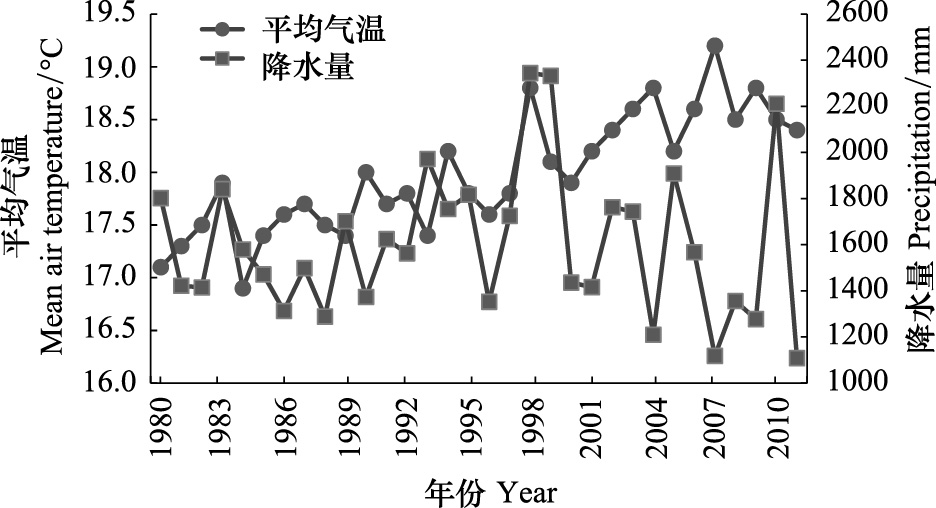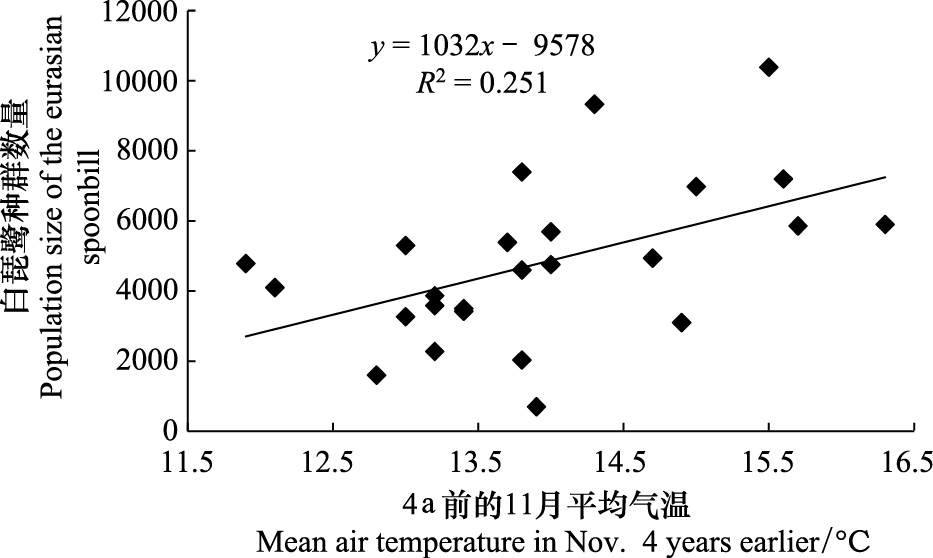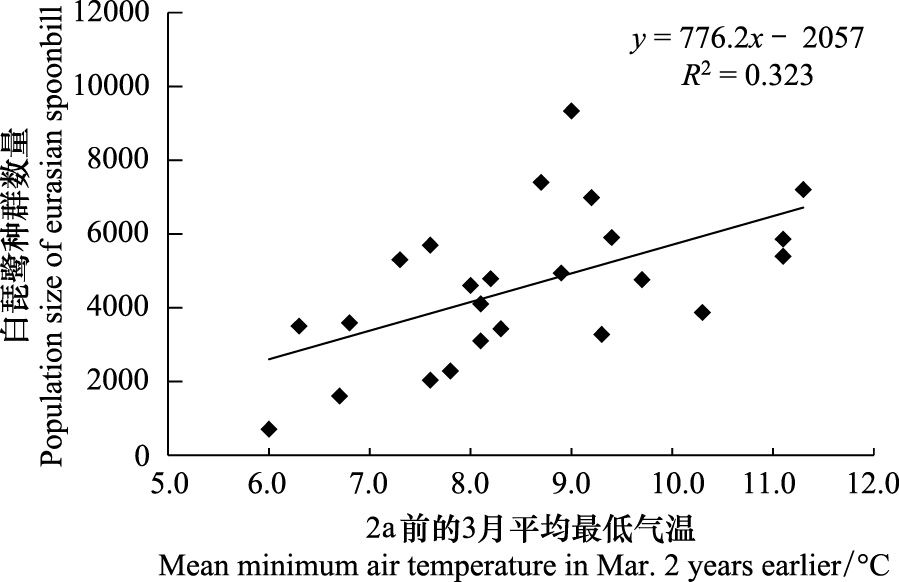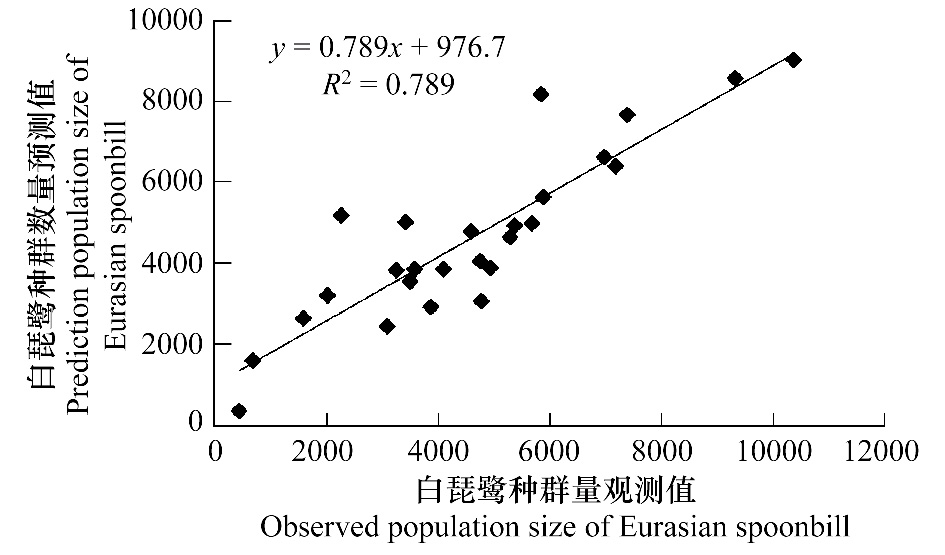文章信息
- 李佳, 李言阔, 缪泸君, 谢光勇, 袁芳凯, 黄燕, 许鹏
- LI Jia, LI Yankuo, MIAO Lujun, XIE Guangyong, YUAN Fangkai, HUANG Yan, XU Peng
- 越冬地气候条件对鄱阳湖自然保护区白琵鹭种群数量的影响
- The effect of climate in wintering area on the population size of the eurasian spoonbill(Platalea leucorodia)in the Poyang Lake National Nature Reserve, China
- 生态学报, 2014, 34(19): 5522-5529
- Acta Ecologica Sinica, 2014, 34(19): 5522-5529
- http://dx.doi.org/10.5846/stxb201309122254
-
文章历史
- 收稿日期:2013-9-12
- 修订日期:2014-7-10
2. 江西师范大学生命科学学院, 南昌 330022
2. College of Life Science, Jiangxi normal university, Nanchang 330022, China
气候条件是影响生物生存的主要环境因子之一,气候变化对鸟类种群的影响受到越来越多的关注,世界自然基金会(World Wide Fund for Nature,WWF)报告指出,全球气候变化使许多鸟类生存受到威胁[1]。国内外一些学者就气候变化对鸟类的影响进行了较为广泛的研究,取得了一系列进展。他们认为气候变化是导致部分鸟类在种群动态[2, 3]、物候(包括产卵期、迁徙期、迁徙距离等)[4, 5, 6, 7]、繁殖率[8]、进化[9]、地理分布[10, 11]等方面发生变化的主要因素。
由于自然种群在经历一个数量波动后通常会进行种群数量的调节,因此气候变化对种群数量的影响很容易被种群数量的密度制约性调节所掩蔽[12]。但是近年来的研究表明,气候会对动物的种群动态有较强的影响[13, 14],气候变化可能会促使种群数量变小甚至灭绝[15],Cormont等调查发现天气条件通过改变食物资源的数量和质量影响成体的存活率和繁殖成功率,进而间接影响鸟类的种群数量[16]。当然,气候变化并非总是导致种群减小,有些物种得益于气候变化及其引起的植被和天敌种群的变化,种群数量增加[17]。可以肯定的是,在未来的一个世纪全球气候还将继续变化,揭示气候变化如何对种群动态施加影响,仍将是一个重要的研究议题[18]。
白琵鹭(Platalea leucorodia),属鹳形目(Ciconiiformes),鹮科(Threskiornithidae),琵鹭属(Platalea),为大型涉禽,被我国列为国家Ⅱ级重点保护野生动物[19]。白琵鹭分布相对广泛,在欧洲、亚洲和非洲均有分布,在我国东北、华北、西北一带繁殖,冬季于长江中下游和华南一带越冬[20]。其中鄱阳湖自然保护区是白琵鹭在长江中下游地区的重要越冬地,近年来,该区白琵鹭种群数量表现出较大的波动[21]。为了在气候变化背景下有效保护生物多样性,科学了解气候变化对白琵鹭种群动态的影响,本研究分析了鄱阳湖国家级自然保护区1985—2011年27a间保护区内越冬白琵鹭种群数量的年际变化,探讨了白琵鹭种群数量变化与其越冬地气候变化的相关性,主要分析了:(1)白琵鹭种群数量变化与其越冬地气候变量是否存在显著的相关性;(2)越冬地气候条件对白琵鹭种群数量波动的影响是否存在时滞效应;(3)基于越冬地气候条件的种群数量波动模型是否能够较好地拟合白琵鹭种群波动趋势。
1 研究地区概况鄱阳湖湿地是我国最大的淡水湖泊湿地,位于长江南岸的江西省北部,地理坐标为115°49′—116°46′E,28°11′—29°51′N。鄱阳湖是一个季节性吞吐型湖泊,既承接赣江、抚河、信江、饶河、修水五大河的来水,同时也受到长江来水的影响。水位年变幅达9.79—15.36 m,4月进入汛期,7月达最高水位,11月进入枯水期,持续到翌年3月,表现为典型的水陆交替出现的湿地景观[22]。该区气候特征属亚热带湿润季风型气候,热量丰富,雨量充沛,无霜期长,四季分明[23]。1980—2011年鄱阳湖区年平均温度为18.0 ℃,平均气温呈增长趋势。气温季节性变化明显,年平均降水量1 603.6 mm,年际变化比较大,但无明显的增减趋势(图 1)。

|
| 图 1 鄱阳湖区1980—2011年平均气温与降水量变化趋势 (基于南昌气象站1980—2011年气象数据) Fig. 1 Annual changes of mean air temperature and precipitation of the Poyang Lake between 1980 and 2011 (based on the weather data from Nanchang weather station) |
鄱阳湖湿地是迁徙水鸟的重要栖息地,已记录的鸟类达310种,其中冬候鸟有155种,夏候鸟107 种,是白鹤(Grus leucogeranus)、白头鹤(G. monacha)、 白枕鹤(G. vipio)、灰鹤(G. grus)、东方白鹳(Ciconia boyciana)、小天鹅(Cygnus columbianus)、白琵鹭等珍稀濒危鸟类的重要越冬地[25]。
2 研究方法鄱阳湖国家级自然保护区1985—2011年白琵鹭越冬种群数量的数据来源包括(1)鄱阳湖国家级自然保护区1985—2000年白琵鹭越冬种群的年最高统计值[24],该研究每年冬季每月对保护区内的9个湖泊进行1—2次的同步调查;(2)鄱阳湖国家级自然保护区2002—2010年白琵鹭每个越冬期的最大种群数量[25],该研究每年冬季每月对保护区内9个湖泊进行3次同步调查(每月的8号、18号和28号);(3)鄱阳湖国家级自然保护区自然资源监测年报[26]、鄱阳湖越冬水禽航空调查报告[27, 28];(4)其他相关的报道[29]。将每年白琵鹭的最高统计值作为鄱阳湖国家级自然保护区每年冬季白琵鹭种群数量的估计值。根据候鸟到达和迁离鄱阳湖的时间,将白琵鹭的越冬期分为越冬初期(当年10月到11月)、越冬中期(当年12月到翌年1月)、越冬后期(翌年2月到3月)。其中,2001年白琵鹭种群数据缺失。气象数据引用《中国地面气候资料月值数据集》南昌监测站1975—2011年的月值资料。
为了分析白琵鹭种群数量动态,本文以白琵鹭种群数量为因变量,年份为自变量,用曲线回归分析了鄱阳湖国家级自然保护区1985—2011年白琵鹭越冬种群数量的年际变化。本研究利用Kolmogorov-Smirnov Test检验越冬期各月的平均气温、平均最低气温、平均最高气温和月降水量等气候变量是否呈正态分布。在检验呈正态分布的基础上利用Pearson相关分析检验了白琵鹭种群数量动态与越冬期各月的平均气温、平均最低气温、平均最高气温和月降水量等气候变量的相关性。为了分析气候变量的影响是否具有时滞效应,检验了越冬地气候变量与其后10a内白琵鹭种群数量的相关性。考虑到极端值对相关分析会产生较大的影响,我们消除极端值,再进行相关性分析,如果仍显著相关则保留。进而,本研究以鄱阳湖国家级自然保护区白琵鹭种群数量作为因变量,将与其存在显著相关性的气候变量作为自变量,进行Stepwise多元线性回归分析,为保证进入模型的气候变量之间的独立性,同时对这些变量进行相关性检验,最终建立起鄱阳湖自然保护区白琵鹭种群数量动态预测模型。数值统计采用平均值±标准误,所有数据分析在SPSS17.0中完成。
3 研究结果 3.1 白琵鹭种群数量年际变化鄱阳湖国家级自然保护区1985—2011年每年冬季白琵鹭种群数量为(4 632±470)只,最小数量出现在1985年,为452只,最大数量出现在2008年,为10 385只;种群数量整体呈显著地线性增长趋势(R2=0.609,F=37.451,df=25,P=0.000),但年际波动较大(图 2)。从2002年冬季开始,鄱阳湖国家级自然保护区白琵鹭越冬种群数量明显增加,1985—2000年,保护区内白琵鹭越冬种群数量为(3288±390)只;2002—2011年,保护区内白琵鹭越冬种群数量为(6781±597)只。

|
| 图 2 鄱阳湖国家级自然保护区1985—2011年白琵鹭种群数量年际变化趋势 Fig. 2 Change trend of population number of Eurasian Spoonbill wintering in the Poyang Lake National Nature Reserve between 1985 and 2011 |
1985—2011年鄱阳湖国家级自然保护区白琵鹭种群数量与越冬初期10月份降水量(R=-0.067,P=0.739,n=26)、平均气温(R=0.377,P=0.057,n=26)、平均最低气温(R=0.354,P=0.076,n=26)、平均最高气温(R=0.325,P=0.106,n=26)均无显著的相关性;与11月降水量(R=-0.090,P=0.663,n=26)、平均气温(R=0.337,P=0.099,n=25)、平均最低气温(R=0.368,P=0.070,n=25)、平均最高气温(R=0.290,P=0.160,n=25)也均无显著的相关性。
考虑时滞效应,10月降水量与2a后的白琵鹭种群数量存在显著负相关(R=-0.461,P=0.023,n=24);10月份平均气温与5a后的白琵鹭种群量存在显著正相关(R=0.517,P=0.008,n=24);10月平均最高气温与2a后的白琵鹭种群数量存在显著正相关(R=0.490,P=0.015,n=24)。11月平均气温与4a后的白琵鹭种群数量存在显著正相关(R=0.501,P=0.011,n=25)(图 3);11月平均最低气温与4a后的白琵鹭种群数量存在显著正相关(R=0.449,P=0.021,n=24);11月平均最高气温与4a后的白琵鹭种群数量存在显著正相关(R=0.460,P=0.021,n=25);11月降水量与8a后的白琵鹭种群数量存在显著正相关(R=0.412,P=0.045,n=24)。

|
| 图 3 鄱阳湖国家级自然保护区1985—2011年白琵鹭种群数量与越冬地4a前11月份平均气温的相关性 Fig. 3 Correlation of the population number of the Eurasian spoonbill in the Poyang Lake National Nature Reserve and the mean air temperature in Nov. 4 years earlier |
白琵鹭种群数量与越冬中期12月份降水量(R=0.110,P=0.594,n=26)、平均气温(R=0.102,P=0.620,n=26)、平均最低气温(R=0.204,P=0.843,n=26)、平均最高气温(R=-0.041,P=0.843,n=26)均无显著性相关性。与1月降水量(R=-0.273,P=0.177,n=26)、平均气温(R=-0.154,P=0.453,n=26)、平均最低气温(R=-0.149,P=0.468,n=26)、平均最高气温(R=-0.144,P=0.484,n=26)也均无显著相关性。
考虑时滞效应,12月平均最低气温与1a后的白琵鹭种群数量存在显著正相关(R=0.455,P=0.022,n=25),与4a后的白琵鹭种群数量存在显著正相关(R=0.618,P=0.001,n=26)(图 4);12月平均气温与4a后的白琵鹭种群数量存在显著正相关(R=0.411,P=0.046,n=24);12月平均最高气温与8a后的白琵鹭种群数量存在显著负相关(R=-0.616,P=0.001,n=24)。1月平均最低气温与5a后的白琵鹭种群数量存在显著正相关(R=0.484,P=0.017,n=24)。

|
| 图 4 鄱阳湖国家级自然保护区1985—2011年白琵鹭种群数量与越冬地4a前12月份平均最低气温的相关性 Fig. 4 Correlation of the population number of the Eurasian spoonbill in the Poyang Lake National Nature Reserve and the mean minimum air temperature in Dec. 4 years earlier |
白琵鹭种群数量与越冬后期2月降水量(R=-0.010,P=0.961,n=26)、平均气温(R=0.248,P=0.222,n=26)、平均最低气温(R=0.292,P=0.148,n=26)、平均最高气温(R=0.191,P=0.349,n=26)均无显著性相关性。与3月降水量(R=0.050,P=0.807,n=26)、平均气温(R=0.243,P=0.231,n=26)、平均最低气温(R=0.211,P=0.300,n=26)、平均最高气温(R=0.246,P=0.226,n=26)也均无显著性相关性。
考虑时滞效应,2月平均气温与2a后的白琵鹭种群数量存在显著正相关(R=0.405,P=0.050, n=24);2月平均最低气温与2a后的白琵鹭种群数量存在显著正相关(R=0.431,P=0.032,n=25)、与8a后的白琵鹭种群数量存在显著正相关(R=0.443,P=0.030,n=24)、与9a后白琵鹭种群数量存在显著正相关(R=0.517,P=0.008,n=25);2月平均最高气温与2a后白琵鹭种群数量存在显著正相关(R=0.412,P=0.041,n=25)。3月平均气温与2a后的白琵鹭种群数量存在显著正相关(R=0.460,P=0.024,n=24)、与4a后的白琵鹭种群数量存在显著正相关(R=0.484,P=0.016,n=24);3月平均最低气温与2a后的白琵鹭种群数量存在显著正相关(R=0.569,P=0.004,n=24)(图 5)、与4a后的白琵鹭种群数量存在显著正相关(R=0.567,P=0.003,n=25);3月平均最高气温与2a后的白琵鹭种群数量存在显著正相关(R=0.545,P=0.005,n=25)、与4a后的白琵鹭种群数量存在显著正相关(R=0.452,P=0.027,n=24)。

|
| 图 5 鄱阳湖国家级自然保护区1985—2011年白琵鹭种群数量与越冬地2a前3月份平均最低气温的相关性 Fig. 5 Correlation of the population number of the Eurasian spoonbill in the Poyang Lake National Nature Reserve and the mean minimum air temperature in Mar. 2 years earlier |
将鄱阳湖国家级自然保护区1985—2011年白琵鹭越冬种群数量作为因变量,与其存在显著相关性的气候变量作为自变量,进行Stepwise线性回归分析,结果表明,2a前的10月平均最高气温(X1)、4a前的11月平均最高气温(X2)、8a前的11月降水量(X3)以及4a前的12月平均气温(X4)是显著的预测变量(表 1)。为保证进入模型中各变量的独立性,对变量两两之间的关系进行了相关性分析。结果表明,进入模型的4个变量两两之间的相关性都不显著(表 2)。进入模型的4个变量共同解释了鄱阳湖国家级自然保护区白琵鹭种群数量变化的78.9%(R2=0.789,F=19.641,df=25,P=0.000),回归模型为Y= -32042.25+869.87 X1+565.09 X2+15.368 X3+573.14 X4,该模型较好地拟合了鄱阳湖国家级自然保护区白琵鹭的种群数量变化趋势(图 6)。
| 自变量 Independent variable | 标准系数 Standard coefficient | t | Sig. |
| 常数项constant | -5.297 | 0 | |
| 2a前的10平均最高气温(X1) Mean maximum air temperature in Oct. 2 years earlier | 0.388 | 3.379 | 0.003 |
| 4a前的11月平均最高气温(X2) Mean maximum air temperature in Nov. 4 years earlier | 0.356 | 3.405 | 0.003 |
| 8a前的11月降水量 (X3) Precipitation in Nov. 8 years earlier | 0.392 | 3.541 | 0.002 |
| 4a前的12月平均气温 (X4) Mean air temperature in Dec. 4 years earlier | 0.287 | 2.599 | 0.017 |
| 气候自变量 Independent variable of climate | 相关系数 Correlation coefficient | 显著性水平 Significant levels |
| (X1) — (X2) | 0.253 | 0.194 |
| (X1) — (X3) | 0.231 | 0.237 |
| (X1) —(X4) | 0.223 | 0.253 |
| (X2) —(X3) | 0.162 | 0.393 |
| (X2) —(X4) | -0.135 | 0.477 |
| (X3) —(X4) | -0.163 | 0.391 |

|
| 图 6 基于越冬地气候条件的白琵鹭种群数量变化模型的预测值与观察值比较 Fig. 6 Comparison of the prediction of Eurasian spoonbill population number in the Poyang Lake National Nature Reserve and the observed population number |
在全球气候发生改变的大趋势下,对于迁徙鸟类,尤其是长距离迁徙鸟类,其种群动态的影响因素比较复杂,越冬地、迁徙停歇地和繁殖地具有差别极大的气候条件,这些地区的气候条件都有可能影响其种群数量。Mller等发现经过长距离迁徙的鸟类由于没有能够及时地适应新环境,导致种群数量下降[30]。极端气候对其生态因子的影响,会使鸟类种群安全受到威胁,当气候变化还在成鸟忍受范围之内,虽然没有对成体构成显著影响,但是可能对幼体来说已经达到致命的强度,使其成活率降低[8]。2008年冬季中国南方地区遭受了严重的冰雪冻灾,几乎覆盖了整个鄱阳湖自然保护区,恶劣气候的直接伤害及其导致的食物短缺,很可能是导致其后两年白琵鹭种群在鄱阳湖自然保护区越冬数量大幅下降的原因,直到2011年种群数量才开始回升(图 2)。研究结果表明,白琵鹭种群数量整体呈显著地线性增长趋势,这可能与鄱阳湖气候变暖有关,温暖湿润的冬季有利于提高白琵鹭越冬食物(如小鱼、虾、腹足类及蠕虫等[31])资源的丰富度和可获得性;同时,越冬期温暖的气候能够降低体温调节所需的能量消耗,有利于白琵鹭在越冬地的存活。
4.2 气候变化对种群数量变化的时滞效应本研究发现,在不考虑气候影响的时滞效应时,白琵鹭种群数量与整个越冬期的各月份的气候变量均无显著的相关性。一般来讲,除非出现极端不利的气候事件,否则整个越冬期的气候条件对白琵鹭种群数量通常不会产生很大的影响。环境的改变,导致种群增长率的改变会发生时滞效应[32]。李言阔等研究气温对鄱阳湖越冬白鹤(Grus Leucogeranus)种群数量的影响时发现,越冬地的气候条件与其后4—7a的白鹤种群数量存在显著性相关[33];Boonstard研究北美野兔(Lepus americanus)时发现,恶劣的环境对其母体和幼体有影响,其时滞效应能持续2—4a[34]。本研究也发现白琵鹭越冬地的气候条件对白琵鹭种群数量的影响存在时滞效应,这种影响通常在1a后开始变得明显,尤其与4a后白琵鹭种群数量的变化存在极显著的相关性,随着气温的升高伴随着4a后白琵鹭种群数量出现极显著的增加。这种时滞效应可能与白琵鹭的性成熟年龄和密度制约性调节有关。一方面,白琵鹭性成熟年龄为4岁[35],适宜的冬季气候条件利于白琵鹭幼体度过冬期,有更多的个体活到繁殖年龄,在4a后能够参加繁殖,导致后期白琵鹭种群数量的增加;另一方面,具时滞的密度制约性通过上升期和下降期的强弱变化导致种群数量周期性波动[32],尤其是2002年之后,以4a为周期的波动性更加明显,在白琵鹭种群数量上升的年份(2002、2005、2008、2011年)(图 2),数量达到高峰之后,其随后年份的数量都会相应的下降,可能是密度制约调节种群数量的结果。
4.3 气候变量与种群数量变化模型目前研究人员主要使用两种方法研究气候变化对鸟类的影响,一种是传统监测方法,另一种是采用模型预测未来气候情景下鸟类的变化。Araújo等认为气候要素平均状态和极端值都对物种群数量有一定的影响,选择不同气候变量分析气候变化对种群数量的影响,每一个气候变量只能反映种群数量与气候要素关系的一个方面,尽可能地选择不同气候变量将提高模拟气候变化对种群数量影响的精度[36]。为准确地确定气候变化对种群数量的影响,本文选择了1975—2011年鄱阳湖自然保护区白琵鹭越冬期月平均气温、月最低气温、月最低气温以及降水量等4个气候变量进行多元线性回归分析,结果表明越冬地2a前的10月平均最高气温、4a前的11月平均最高气温、8a前的11月降水量以及4a前的12月平均气温,是4个显著的预测变量,共同解释了鄱阳湖国家级自然保护区白琵鹭种群数量变化的78.9%。其中前3个变量可以共同解释白琵鹭种群数量变化的72.1%,这两个月份(包括10月和11月)正是白琵鹭的越冬初期,是结束长距离迁徙的阶段,可能是白琵鹭补充能量的关键时期,这个时期越冬地恶劣的天气可能导致白琵鹭无法获得充足的能量,不利于能量的恢复,从而给种群造成不利的影响。
4.4 关注气候变化对鄱阳湖鸟类的影响我国鸟类资源丰富,从地理区系看,我国地跨古北、东洋两个动物地理界,鸟类区系丰富,很多迁徙鸟类在我国既有繁殖地又有越冬地,气候变化对鸟类生存环境的影响是多方面的,这种影响的利弊目前还很难给予定论。鄱阳湖湿地是迁徙水鸟的重要栖息地,研究气候变化对鄱阳湖鸟类种群的影响无疑对了解气候变化对鸟类的影响具有重要的参考价值。有研究表明,气候变化是导致鄱阳湖湿地功能退化的主要原因,对鸟类栖息、觅食、繁殖等有重要影响[37]。目前,对气候变化趋势的研究表明,鄱阳湖未来极端气候可能会有所增加[38],鸟类专家既要关注气候变化对鸟类的直接影响,比如迁徙和繁殖时间的变化;也要重视气候变化对鸟类的间接影响,比如食物丰富度和生境结构的变化,以便更好地应对全球气候变化对鸟类种群变化的可能影响,特别是对濒危鸟类的保护和管理的影响。
| [1] | Wormworth J, Mallon K. Bird Species and Climate Change: A summary of The Global Status Report.2007.http://wwf.panda.org/about_our_earth/aboutcc/problems/impacts/species/cc_and_birds/ |
| [2] | Yin W Q, Yu J, Guo L, Zhao Y L, Wu Y H. Impacts of Environmental Variation on population Structure of Birds. Environmental Science and Management, 2013, (38)5: 166-169. |
| [3] | Gasner M R, Jankowski J E, Ciecka A L, Kyle K O, Rabenold K N. Projecting the local impacts of climate change on a Central American montane avian community. Biological Conservation, 2010, 143(5): 1250-1258. |
| [4] | Both C, Artemyev A V, Blaauw B, Cowie R J, Dekhuijzen A J. Large-scale geographical variation confirms that climate change causes birds to lay earlier. Proceedings of the Royal Society of London, 2004, 271: 1657-1662. |
| [5] | Li S Z, Tang W B, Tang X. Influence of Climate Condition on Change of Phenophase of Barn Swallow. Journal of Auhui Agricultural Sciences, 2009, 37(18): 8531-8532. |
| [6] | Butler C J. The disproportionate effect of global warming on the arrival dates of short-distance migratory birds in North America. Ibis, 2003, 145: 484-495. |
| [7] | Miller-Rushing A J, Lloyd-Evans T L, Primack R B, Satzinger P. Bird migration times, climate change and changing population sizes. Global Change Biology, 2008, 14: 1959-1972. |
| [8] | Stokke B G, Moller A P, Sather BE, Rheinwald G, Gutscher H. Weather in the breeding area and during migration affects the demography of a small long-distance passerine migrant. The Auk, 2005, 122(2): 637-647. |
| [9] | Karell P, Ahola K, Karstinen T, Valkama J, Brommer J E. Climate change drives microevolution in a wild bird. Nature Communications, 2011, 2: 208. |
| [10] | Chen I C, Hill J K, Ohlemüller R, Roy D B, Thomas C D. Rapid range shifts of species associated with high levels of climate warming. Science, 2011, 333: 1024-1026. |
| [11] | Du Y, Zhou F, Zhou X L, Li Y L. The impact of global warming on China avifauna. Acta Zootaxonomica Sinica, 2009, 34(3): 664-674. |
| [12] | Crick H Q P. 2004. The impact of climate change on birds. Ibis (Suppl.1), 146: 48-56. |
| [13] | Stenseth N C, Mysterud A, Sen G, Hurrell J W, Chan K S, Lima M. Ecological effects of climate fluctuations. Science, 2002, 297: 1292-1296. |
| [14] | Altwegg R, Dummermuth S, Anholt B R, Flatt T. 2005. Winter weather affects asp viper Vipera aspis population dynamics through susceptible juveniles. Oikos, 110:55-66 |
| [15] | Mclaughlin J F, Hellmann J J, Boggs C L, Ehrlich P R. Climate change hastens population extinctions. Proceedings of the National Academy of Sciences of USA, 2002, 99(9): 6070-6074. |
| [16] | Cormont A, Vos C C, Van Turnchout C A M, Foppen R P B, Ver Braak C J F. Using life-history traits to explain bird population responses to changing weather variability. Climate Research, 2012, 49(1): 59-71. |
| [17] | Albon B S D, Clutton-brock T H, Guinness F E. Early development and population dynamics in red deer. Ⅱ. Density-independent effects and cohort variation. Journal of Animal Ecology, 1987, 56:69-81. |
| [18] | McKellar A E, Marra P P, Hannon S J, Studds C E, Ratcliffe L M. Winter rainfall predicts phenology in widely separated populations of a migrant songbird. Oecologia, 2013, 172: 595-605. |
| [19] | China Wildlife Propagation Institution for Protection. The Law of Wild Animal Protection of People′s Republic of China (1989) // List of Wild Animals Under National Protection. Beijing: Legal Press. |
| [20] | Liu J S, Yang X Z, Li Y F. Observation on the breeding habit of white spoonbill and the development of its nesting. Zoological Research, 1997, 32(2): 249-253. |
| [21] | Jin J F, Liu G H, Jin Z F, Wu J D, Zeng N J, Gao X. Distribution and Status of Wintering Eurasian Spoonbills in Poyang Lake Nature Reserve. Chinese Journal of Zoology, 2011, 46(2): 59-64. |
| [22] | Liu C L, Tan Y J, Lin L S, Tao H N, Tan H R. The wetland water level process and habitat of migratory birds in Lake Poyang. Journal of Lake Science, 2011, 23(1): 129-135. |
| [23] | Wang X H. Wetland ecosystem assessment of Poyang Lakes. Beijing: Science Press, 2004. |
| [24] | Wu Y H, Ji W T. Study on Jiangxi Poyang lake national nature reserve. Beijing: China Forestry Press, 2002. |
| [25] | Li F S, Liu G H, Wu J D. Ecological study of wetlands and waterbirds at Poyang Lake. Beijing: Popular Science Press, 2011. |
| [26] | Zhu Q, Liu G H, Wu J D. The annual report on nature resource monitoring of Poyang Lake National Nature Reserve in 2010. Shanghai: Fudan University Press, 2012. |
| [27] | Wu J D, Ji W T, Liu G H, Wu X D, Gong L Q, Wang S Q, Gao Y Y, Zou N, Zhan H Y, Luo H, Gao X, Guo Y J, Wang X L, Yang Y. Number and Distribution of Over-wintering Waterbirds in the Poyang Lake by Aerial Survey. Jiangxi Forestry Science and Technology, 2010, 1: 23-28. |
| [28] | Ji W T, Zeng N J, Wu X D, Wu J D, Wang X L. Aerial Survey Report on Cranes and Large Size Water Birds in Poyang Lake Natural Reserve in Spring of 1999. Jiangxi Forestry Science and Technology, 2000, 5: 22-25. |
| [29] | Zhu Q, Zhan H H, Liu G H, Wu J D, Zhan H Y, Huang Y Z, Huang J, Zhang B, Hu B H, Li Y. Investigation of Number and Distribution of the Waterfowl of Poyang Lake in the Winter of 2011. Jiangxi Forestry Science and Technology, 2012, 3: 1-9. |
| [30] | Mller AP, Rubolini D, Lehikoinen E. Populations of migratory bird species that did not show a phenological response to climate change are declining. Proceedings of the National Academy of Sciences, 2008, 105: 16195-16200. |
| [31] | Hu W H, Yu G Q, He S C, Liu Z Y, Xu W B. Wintering Ecology Research of Eurasian Spoonbills. Land and Natural Resources Research, 1999, 1: 69-71. |
| [32] | Sun R Y. Principles of Animal Ecology (The third). Beijing Normal University Press, 2001, 192-193. |
| [33] | Li Y K, Qian F W, Shan J H. The effect of climate change on the population fluctuation of Siberian crane in the Poyang Lake. Acta Ecologica Sinica, 2014, 34(10):2645-2653. |
| [34] | Boonstar R, Krebs C J, Stenseth N C. Population cycles in small mammals: the population of explaining the low phase. Ecology, 1998, 79(5): 1479-1488. |
| [35] | Navedo J G. Different stopover timing in juvenile and adult spoonbills during southward migration. EUROSITE Spoonbill Working Group Newsletter, 2008, 6: 2-5. |
| [36] | Araújo M B, Pearson R G, Thuiller W, et al. Validation of species-climate impacts models under climate change. Global Change Biology, 2005, 11:1504-1513. |
| [37] | Fan J Y, Zhao G N, Zhang J P. Climate change and its influences on local ecological environment of Poyang Lake Area. ShanDong Science, 2009, 22(3): 34-39. |
| [38] | Guo H, Yin G Q, Jiang T. Prediction on the possible climate change of Poyang Lake basin in the Future 50 Years. Resources and Environment in the Yangze Basin, 2008, 17(1): 73-78. |
| [2] | 殷伟庆, 余俭, 郭蕾, 赵一亮, 吴英红.环境变化对鸟类种群结构的影响研究. 环境科学与管理, 2013, (38)5: 166-169. |
| [5] | 李世忠, 唐伍斌, 唐欣. 气候条件对家燕物候期变化的影响. 安徽农业科学, 2009, 37(18): 8531-8532. |
| [11] | 杜寅, 周放, 舒晓莲, 李一琳. 全球气候变暖对中国鸟类区系的影响. 动物分类学报, 2009, 34(3): 664-674. |
| [20] | 柳劲松, 杨秀芝, 李去芳. 白琵鹭繁殖及雏发育的观察. 动物学研究, 1997, 32(2): 249-253. |
| [21] | 金杰锋, 刘砚华, 金志芳, 吴建东, 曾南京, 高翔. 鄱阳湖保护区白琵鹭越冬种群分布. 动物学杂志, 2011, 46(2): 59-64. |
| [22] | 刘成林, 谭胤静, 林联盛, 陶海南, 谭晦如. 鄱阳湖水位变化对候鸟栖息地的影响. 湖泊科学, 2011, 23(1): 129-135. |
| [23] | 王晓鸿. 鄱阳湖湿地生态系统评估鄱阳湖湿地生态系统评估. 北京: 科学出版社, 2004. |
| [24] | 吴英豪, 纪伟涛. 鄱阳湖国家级自然保护区研究. 北京: 中国林业出版社, 2002. |
| [25] | 李凤山, 刘观华, 吴建东. 鄱阳湖湿地和水鸟的生态研究. 北京: 科学普及出版社, 2011. |
| [26] | 朱奇, 刘观华, 吴建东. 2010年鄱阳湖自然保护区自然资源监测年度报告. 上海: 复旦大学出版社, 2012. |
| [27] | 吴建东, 纪伟涛, 刘观华, 伍旭东, 龚磊强, 王水清, 高云云, 邹楠, 詹慧英, 罗浩, 高翔, 郭玉江, 王小龙, 杨燕. 航空调查越冬水鸟在鄱阳湖的数量与分布. 江西林业科技, 2010 (1): 23-28. |
| [28] | 纪伟涛, 曾南京, 伍旭东, 吴建东, 王小龙. 1999年春鄱阳湖鹤类和大型水禽航空调查报告. 江西林业科技, 2000 (5): 22-25. |
| [29] | 朱奇, 詹耀煌, 刘观华, 吴建东, 詹慧英, 黄元政, 黄江, 章斌, 胡斌华, 李跃. 2011年冬鄱阳湖水鸟数量与分布调查. 江西林业科技, 2012, (3): 1-9. |
| [31] | 胡维华, 俞贵庆, 何山春, 刘政源, 徐文彬. 白琵鹭的越冬生态研究. 国土与自然资源研究, 1999, 1: 69-71. |
| [32] | 孙儒泳. 动物生态学原理(第三版). 北京师范大学出版社, 2001, 192-193. |
| [33] | 李言阔, 钱法文, 单继红. 气候变化对鄱阳湖白鹤越冬种群数量变动的影响. 生态学报, 2014, 34(10):2645-2653. |
| [37] | 攀建勇, 赵冠男, 张建萍. 鄱阳湖区气候变化及其对生态环境的影响. 山东科学, 2009, 22(3): 34-39. |
| [38] | 郭华, 殷国强, 姜彤. 未来50年鄱阳湖流域气候变化预告. 长江流域资源与环境, 2008, 17(1): 73-78. |
 2014, Vol. 34
2014, Vol. 34




